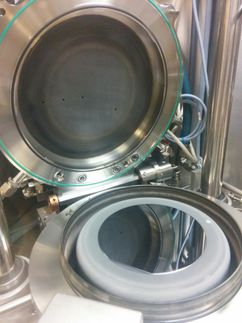Materials That Shrink When Heated
One common reason that people with fillings experience toothache is that their fillings expand at a different rate to the original tooth when, for example, drinking a hot drink. Contrary to intuition, however, not all materials expand when heated - some actually contract. Recent research on these so-called negative thermal expansion (NTE) materials has led to the discovery of alloys exhibiting unexpectedly large thermal contraction.
Controlling the thermal expansion of composites is important for producing nanometer-scale electronic circuits, as well as the next-generation fuel cells and thermoelectric devices. An ability to combine NTE materials with 'normal' materials which expand upon heating ensures a reduction in thermal expansion in a composite material - something that people with tooth fillings would appreciate. An example of such a composite is Invar, an iron-nickel alloy with a uniquely low coefficient of thermal expansion. As a result it is used where high dimensional stability is required, such as precision instruments, clocks or seismic creep gauges.
Koshi Takenaka at the Department of Crystalline Materials Science, Nagoya University in Japan works on NTE materials for practical applications. In the latest issue of Science and Technology of Advanced Materials he summarizes the physical mechanisms governing NTE with emphasis on recent developments.
Takenaka notes that, "NTE materials will expand our capability of thermal-expansion control, opening a new paradigm of materials science and technology thermal-expansion-adjustable composites". One challenge facing the scientist is that the addition of NTE materials to composites leads to undesirable instabilities at interfaces. New methods for producing stable interfaces between the host composite and NTE compensators are of critical importance. Nevertheless, the so-called 'one-component' materials - such as manganese antiperovskites, zirconium vanadates, and hafnium tungstates - exhibiting negligible thermal expansion offer a promising route towards achieving this goal.
Original publication
Koshi Takenaka et al. "Negative thermal expansion materials: Technological key for control of thermal expansion"; Science and Technology of Advanced Materials Vol. 13 (2012) 013001.
Most read news
Original publication
Koshi Takenaka et al. "Negative thermal expansion materials: Technological key for control of thermal expansion"; Science and Technology of Advanced Materials Vol. 13 (2012) 013001.
Organizations
Other news from the department science

Get the chemical industry in your inbox
By submitting this form you agree that LUMITOS AG will send you the newsletter(s) selected above by email. Your data will not be passed on to third parties. Your data will be stored and processed in accordance with our data protection regulations. LUMITOS may contact you by email for the purpose of advertising or market and opinion surveys. You can revoke your consent at any time without giving reasons to LUMITOS AG, Ernst-Augustin-Str. 2, 12489 Berlin, Germany or by e-mail at revoke@lumitos.com with effect for the future. In addition, each email contains a link to unsubscribe from the corresponding newsletter.

























































